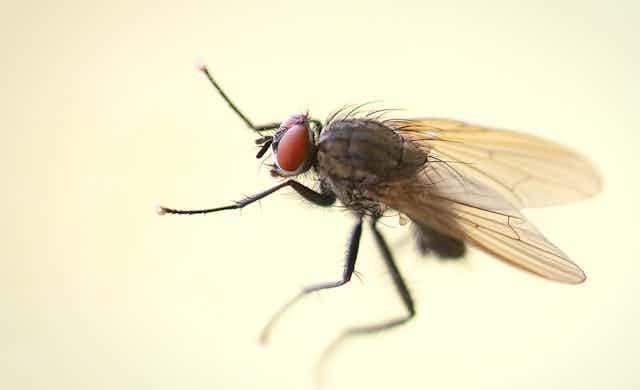How can researchers study the effects and causes of ageing, and the difference in this regard between males and females? In our case, we looked at flies. And more specifically, the mitochondria of these insects.
Mito-huh?
All things need a motor to run. The V8 engine responsible for giving energy to every cell in our body is called the mitochondria. Mitochondria are the only organelles that have DNA in the animal kingdom and the main purpose of this DNA is to help with energy production.
As a consequence, energy production is coordinated by two parties: the mitochondria and the nucleus (where DNA is stored inside the cell). Accurate communication between the two is thus crucial for efficient energy production.
In addition to providing all the energy our cells need, these energy powerhouses are also responsible for leaking molecules called Reactive Oxygen Species – also known as free radicals. ROS are one of the cell’s most dreaded molecules, causing an immense amount of damage.
When enough is produced, it will result in the death of the cell. These little molecules are what make high antioxidant foods so popular, since they counteract the negative effects of ROS.
Though not intentional, free radicals are able to leak out of the energy production cascade when machinery is not functioning in unison. If the communication between the mitochondrial DNA and the nuclear DNA is not optimal, this increases the chances of system malfunction and the leakage of toxic molecules.
So how is this energy factory involved with the process of ageing?
One of the main theories that tries to explain why all living organisms age is called the Mitochondria Theory of Ageing. This theory states that ROS molecules that escape damage the DNA that’s found inside the mitochondria.
This means that the cross talk between the mitochondria and the nucleus deteriorates causing the energy production to be less efficient. If the energy machinery is not efficient, more toxic molecules are able to escape and harm the cell – leading to a vicious cycle whereby the machinery becomes less efficient and more free radicals are able to escape. Through time, this process will lead to the decay of cells and the deterioration of the whole organism.

Male vs female mitochondria
Although mighty, this organelle is not passed to the next generation by both males and females but only from mother to offspring. This means that our mitochondria are the same as our mothers’ and grandmothers’ mitochondria.
Unfortunately for males, they do not get the opportunity to pass on their mitochondria to the next generation and are considered a mitochondria evolutionary dead-end.
Not all things that are beneficial in females are also good in males, so as mitochondria adapt to better suit female needs, this may cause a disadvantage in males with time.
Thus mitochondria are theoretically better functioning in females than males, since all the cross-talking between both genomes has had hundreds of generations of evolution which can only occur in females as they pass on their mitochondria to the next generation.
What we did
In order to examine the effects that the mitochondria have on ageing, we had to create unique flies. All flies had the same nuclear environment - the same chassis. The only thing that differed between the flies was the mitochondria.
That means any difference that we found across the flies was solely due to the motor of the cell. With these fly lines we performed an ageing assay on males and females separately. Starting with 15,000 flies, we counted the number of dead flies almost on a daily basis.
In addition to looking at how long the flies lived for, we extracted the mitochondrial DNA and looked at differences at the DNA level between the fly lines.
What we found
On average we found that female flies across all our lines lived significantly longer than males by 20%. We also found that “senescence”, or the rate of ageing, was higher in males than females. That means males get older quicker and thus die at a younger age.
When we examined all the female flies, no differences could be seen between the different mitochondria, but males were a different story. Depending in which mitochondria the males had, males lived almost as long as females or died extremely young.
There was great variation, and this variation can only be explained by the mitochondria that the individuals carried.
Ageing is something we all face and something we are all inherently curious about. We believe our study brings us a step closer to understanding how it works.

